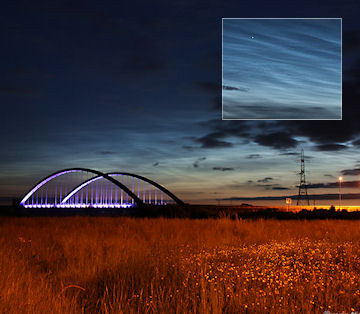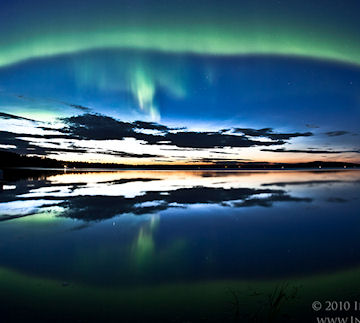NEW AND IMPROVED: Turn your iPhone or iPod Touch into a field-tested global satellite tracker. The Satellite Flybys app now works in all countries. | | | NEW SUNSPOT: Magnetic fields are coalescing in the sun's northeastern quadrant to form a new sunspot. The growing active region is crackling with B-class flares, as shown in this movie from NASA's Solar Dynamics Obervatory. HUBBLE FINDS NO DEBRIS: Even the Hubble Space Telescope cannot find any debris where an unknown object apparently hit Jupiter on June 3rd. Today, researchers released new HST images of the impact site, which show nothing but uninterrupted clouds. The non-detection is consistent with a relatively small asteroid or comet fragment making a shallow impact in Jupiter's high atmosphere. [more] ELECTRIC BLUE CLOUDS: Observers in Europe are reporting brightening displays of noctilucent clouds (NLCs). "On June 16th, a stunning display appeared in the skies over Northern Ireland," reports Martin McKenna. "Here they are glowing over the famous 'Toome Bridge' in County Antrim." 
"The clouds stretched more than 160 degrees across the sky with wonderful electric blue colours," he adds. "Well-formed bands and whirls could be seen moving in real time." Summer is the season for NLCs, and sightings should increase in frequency as the season unfolds in the weeks ahead. The solar cycle also favors a good show: There is a well-known correlation between noctilucent clouds and sunspots. NLC activity tends to peak during years of solar minimum, possibly because low solar activity allows the upper atmosphere to cool, promoting the growth of ice crystals that make up the clouds. With the sun slowly emerging from a century-class minimum, the stage is set for a good season of NLC watching. more images: from Conor McDonald of Maghera, Ireland; from Martin McKenna of Maghera, Co. Derry, N. Ireland; from Pete Glastonbury of Avebury, Wiltshire, UK; from Stuart Atkinson of Kendal, Cumbria, UK; from George of Moscow, Russian Federation; Observing tips: Look west 30 to 60 minutes after sunset when the Sun has dipped 6o to 16o below the horizon. If you see luminous blue-white tendrils spreading across the sky, you may have spotted a noctilucent cloud. High-northern latitudes are favored. GEOMAGNETIC ACTIVITY: A solar wind stream is buffeting Earth's magnetic field and causing geomagnetic activity around the poles. Zoltan Kenwell sends this picture taken June 16th from a lake shore 150 miles north of Edmonton, Alberta: 
"The display was brief--only about 3 minutes from beginning to end--but beautiful," says Kenwell. "I was not disappointed!" NOAA forecasters estimate a 60% chance of more geomagnetic activity tonight as the solar wind continues to blow. High-latitude sky watchers should remain alert for auroras. May 2010 Aurora Gallery
[previous Mays: 2008, 2005, 2004, 2003, 2002] [aurora alerts] | 
